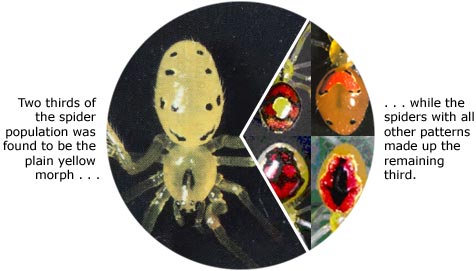Following a tip from Sam Gon, a biologist from the islands, Gillespie and Tabashnik began their studies with the happy-face spiders on the island of Maui. They found that roughly two-thirds of the population was the yellow morph and one-third was of other patterns.
The “other” patterns included plain red, plain white, red smiles, and red frowns. There was no consistency within the occurrence of the “other” patterns, but the two yellow to one “other” occurred generation after generation. The researchers always found about two yellow morphs for every one non-yellow morph.
When Gillespie and Oxford went on to study the happy-face spiders on the other islands, they were surprised by their results. Not only did each island harbor the same sorts of morphs, but the different morphs also occurred at almost exactly the same frequency in each population. Just as in Maui, the frequency of yellow morph spiders to those with other patterns was 2:1.
Why is that so surprising? Well, if you rolled a pair of dice and got a two and a one you wouldn’t be surprised. But if you rolled the same dice again and got a two and a one, and again and got a two and a one, and again and got a two and a one, you’d start to wonder what was going on! Gillespie and Oxford were similarly surprised. Why were the same color patterns found at the same frequency on each of the four islands? What was going on?
In the process of answering that question, Gillespie and her colleagues would learn some interesting things about the evolution of the happy-face spider.
Get tips for using research profiles, like this one, with your students.

